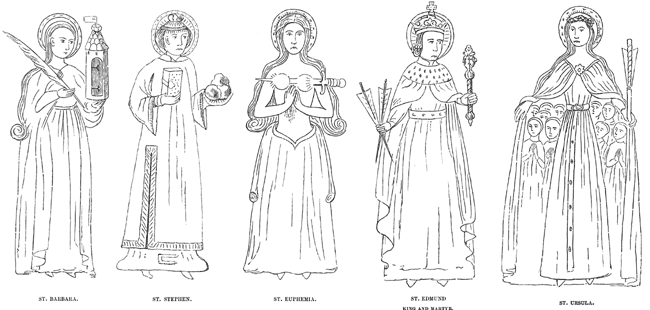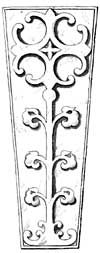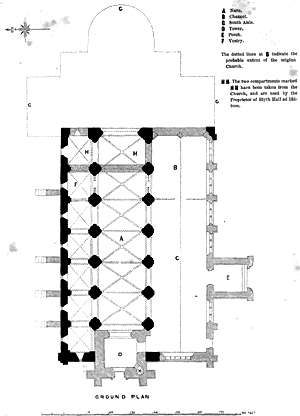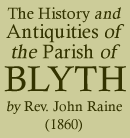< Previous | Contents | Next >

Painted figures in lower panels of chancel screen. Left to right: St. Barbara, St. Stephen, St. Euphemia, St. Edmund King and Martyr, St. Ursula.
Henceforth the convent and the parish possessed each their own chancels, which in process of time were defined by two separate rood-lofts in a line with each other, crossing the nave and south aisle. The latter of these screens remains, and the painted figures which I have given at the end of the volume, and which were brought to light in 1842 from the boards and matting of pews, behind which they were concealed, may now be seen with sufficient distinctness, though with a few marks of puritanical violence; with the exception of that of St. Ursula, which was found in such a state of decay as to justify its removal to a place of safe preservation. Other figures on the panels of the parish rood-screen have been cut away to make a road to the reading-desk and pulpit. The rood-loft of the convent has fared worse. With the exception of a fragment at the corner of the private gallery of Blyth Hall and the lower panels, it has been destroyed; and, what is hardly less annoying, these panels, all perfect though they are, are daubed over with paint, so as completely to obliterate the figures, except at the very base.
The next change which the church underwent was the construction of the present tower, which possesses great beauty, and is a striking feature both of the church itself and of the surrounding country. From an examination of the nave, both within and without, it is clear that a portion of it was taken down to make room for the tower, which at its two western angles, where it is not engaged in the wall of the nave, is flanked with buttresses of seven stages at right angles with the sides, is lighted with double-transomed belfry windows, and crowned with a remarkably light and elegant parapet, whilst its western door is decorated with crocketed canopy and buttresses pierced with panels, above which are three niches of good character, one elevated above the other two, containing in ancient times, we may presume, figures of our Lord, the blessed Virgin, and St. John the Evangelist, long since removed. The tower was built about the middle of the fifteenth century, and no work of any importance was done after it.
Previous to the year 1841 the tower contained four bells; the first of which bore the inscription "Jesus be our speed;" the second, in black letter, "Ioannes Baptista;" the third, "Benedicta sit Sancta Trinitas. Ioannes Cossale arte xpi composuit, a.d. m.ccccxxi;" the fourth the date 1620. The third bell appeared to have been recast and was cracked, and all of them to have been hung at different times; in consequence of which they were not in harmony.
In the above year they were therefore taken down, recast, and two additional bells made, by Mr. Taylor, bell-founder, of Oxford and Loughborough. The new ring of bells was received at Blyth on the 2nd September, 1842, preceded by a band of music, and accompanied to the church by the inhabitants, who exhibited the most lively demonstrations of joy on the occasion. I should do extreme violence to my own feelings, if I omitted to mention that for this great and much needed improvement the parish was very largely indebted to the zeal, the taste, and the liberality of two young gentlemen, then my pupils, now my friends, and one of them a most dear friend too; who, although they have been gone from my roof for now nearly twenty years, are still remembered by both rich and poor of this place with feelings of sincere respect and esteem. I mean Augustus and Henry George Sutton, sons of the late Sir Richard Sutton, of Lyndford Hall, Norfolk, and of Norwood, in the county of Nottingham, Baronet.
The tower once possessed chimes, which have disappeared many years ago. A brass tablet used to hang in the ringing loft with this inscription: "This chime was made and set up by Tho. Kirkall of Sheafield. William Tomlinson and Gervase Mitton being churchwardens this present year 1686. Sexton, look to your charge. The work is good and large."
The latest feature in the church is the Tudor window at the west end of the south aisle, which probably superseded one of smaller dimensions, like those in the south side of the same aisle.
Ancient wills speak of guilds or fraternities of Corpus Christi and St. George, and a torch guild, to which legacies of money, corn, or land were frequently bequeathed; and of four principal lights, as well as probably of others, some of which were known by the names of Blyth Light, Strop (Styrrup) Light, the Plough Light, the Light of St. Sitha, and the Light of St. Bridget, to which also money was constantly left.
I discover no vestiges of the existence of chantries.
The parish possesses to this day lands in the townships of Blyth and Styrrup, the rents of which go to the general purposes of the church. They probably have a mixed origin, arising from legacies left "fabricæ ecclesiæ" to the fabric fund, to the guilds, and to the vicars, with a view to secure the performance of religious offices. Thus, so late as 1504, Thomas Hugh of Blyth settled an acre of land in Blyth on the vicars of Harworth and Blyth for ever, 4d. to be paid out of it yearly to the former to pray for him and his wives every Sunday, the remainder of the rent to go to the vicar of Blyth on the same conditions.
Our ancient monuments have been treated with savage recklessness. Till within the last few years the western bay of the north aisle was walled off from the church, and coals deposited in it. On removing this wall we found it contained fragments of figures of knights in elaborately wrought chain armour, and of ecclesiastics in delicately carved drapery. And doubtless the church was, in times of old, very richly ornamented with the monumental effigies of great and good men, lay and ecclesiastical, some of whom had benefited, and all of whom had revered it whilst living, and whose dying wish it was that their bones should rest in peace under its sacred roof. But the destruction of the monasteries by a sensual, selfish, cruel tyrant, and the Reformation which followed—productive of incalculable good in some respects though the latter was—undoubtedly poured a torrent of irreverence over the land, from the effects of which our sanctuaries are suffering to this very day
Thou jealous, ruthless tyrant! Heaven repay
On thee and on thy children's latest line
The wild caprice of thy despotic sway,
The gory bridal bed, the plundered shrine,
The murdered Surrey's blood, the tears of Geraldine.

Stone coffin lid.
One ancient monument alone remains perfect, a plain slab in the chancel, with this modest inscription, so exceedingly unlike the presumptuous bombast of modern clays: "Orate pro anima domini Iohannis Albarne quondam vicarii do Blida, qui obiit vicesimo sexto die mensis Junii, anno Domini MoCCCCoLXXoVIo." Of other slabs, and crosses, and inscriptions, numerous fragments, but only fragments, are to be seen. The stone coffin lid, of which I have given an engraving, was found in the church floor with its face downwards.
The archbishops of York during their occasional residence at the palace of Scrooby, within four miles of us, would find the church of Blyth the only sufficiently large and convenient one in the neighbourhood for purposes of ordination, and would consequently "celebrate orders" in it. Thus in 1356 archbishop Thoresby, as we find from his register, held an ordination in our church "die Sabbati quatuor temporibus proximo post festum sanctæ Luciæ virginis:" that is, on the Saturday in the Ember week next after the feast of St. Lucy the virgin; and conferred the four orders of sub-deacon, deacon, priest, and acolyte on persons not only of his own but of dioceses as remote and distant from each other as St. Andrew's, Lichfield and Coventry, Norwich, Carlisle, and Lincoln. Some were ordained ad titulum paupertatis, which was that of a monk; some ad titulum patrimonii sui, which was that of a man of a certain private income; and some ad titulum beneficii sui, that of a benefice. Some ad omnes ordines, that is, to all the minor orders at once of ostiarius, lector, exorcist, and acolyte, and to the major order of sub-deacon. Some to the orders of sub-deacon and deacon at once. Since the Council of Trent this ordination of a person as sub-deacon and deacon on the same day has been discontinued in the Church of Rome, and intersticia, or an interval of twelve months, must transpire between the two.

Blyth church.
I now come to the destroyed, the severed, and the mutilated portions of our church. The external view and the ground plan will, with what has already been said, enable my readers to understand with sufficient, and I doubt not with painful, clearness the destruction and the spoliation which this sanctuary has undergone. The dotted lines in the ground plan indicate a transept and choir terminating in an apse, now destroyed. And here I must state that this part of the plan is not founded on mere inference, for on September 14, 1857, on being informed by the then gardener of Blyth Hall, an intelligent man, that he had discovered, in making a garden walk in the pleasure grounds cast of the church, the foundations of a round wall, and on receiving from him an account of the precise situation of such foundations, I made a measurement from the spot occupied by the head of this round wall, which was doubtless the boundary wall of the apse, to the foot of the outer arch now in the hall garden, and found the distance to be 61 feet. In the same engraving the letters H H point out a bay of the nave and a bay of the north aisle severed from the church, and claimed by Mr. Walker as owner of Blyth hall.
The external view of the church discloses a round arch at the east end, being one of the four upon which the central Norman tower rested. As the stranger advances up the churchyard of Blyth his attention is arrested by the singular appearance of the east end of the church. He sees a stately arch with a dark deep grotto-looking place behind it, commonly known as the Aviary— a name which explains itself. He further observes the eastern wall finished off at the top in two inverted semi-cycloid looking lines partly with modern tiles; no eastern window; and the eastern and northern sides of the church entirely cut off from the churchyard and the access of the parishioners by a wall built of stones, which from their very form and aspect prove that they came from the church or the monastic buildings.
Can any account be given of this scandalous and deplorable desecration? To answer this question I must premise that the first lay settlers on the site of the ancient monastery planted themselves on a spot which, however convenient to them from foundations and walls already made to their hands, was far too near the church to be productive of anything but mischief to it. The Saundersons, and others before them, had since the Dissolution resided at Blyth Abbey, as the house was then called; and it is only fair, although we cannot prove the fact, to suppose that they had some share in the work of destruction, by permitting, if not encouraging, dilapidation of the eastern portions of the church to go on. From the Saundersons the estate passed by purchase to the Mellishes in 1635. In 1684 Edward Mellish, the son of the purchaser, pulled down the old hall and built a new house. He kept a diary with full accounts of his expenditure, and in 1689 he tells us what the new house, with "outhouses and walls about the grounds, repairing the church end, making the vault and pew in the church" (I quote his own words), and other matters, had cost him. I cannot but think, then, that Edward Mellish, finding the church end as he calls it in a dilapidated state, for we must suppose that the conventual choir had fallen into disuse, really, although by a soft euphemism he speaks only of repairing, levelled to the ground the portion of the choir east of the transept, together with the transept and central tower; that he severed the bay of the north aisle and the bay of the nave from the church, and turned them to secular uses; cut off all approach to the eastern and northern sides of the church by a wall; finished off the eastern end in the manner in which we now see it, and blocked up the lower windows of the north aisle, which happily were re-opened twenty years ago.
Certain it is, for habemus comfitentem reum, that he made the large family vault under the severed bay of the nave, and the pew, that is gallery, in the north aisle, cutting pier and capital and window in the most wanton manner, taking up one entire arch of the nave with his steps, projecting his "pew" far in advance into the nave through another arch, and establishing under it in the back-ground a dark and dismal dungeon, which ever since his day has witnessed every detestable abomination.
And now if any of my distant readers should ever enter Blyth church they will see Edward Mellish reposing in effigy against the dead boundary wall of the nave, on his right arm, on a soft pillow, under elegant drapery, and an elaborate panegyric, quietly and complacently, as if utterly unconscious of having done any wrong to the sacred edifice.
I have only to add, by way of completing my account of the desecration and mutilation of the church, that at some period subsequent to the spoliation of the convent the outer roof of the north aisle has been dropped beneath the openings of the triforium, and these openings have been turned into windows, the heads of the arches being blocked up with masonry. What adds to the singularity of the whole is, that the ground under the aviary, now no longer I am glad to say used for the purpose implied by the name, is occupied by the vault of the Mellish family, which in my time has been three times opened for the interment of the dead; and that the roof above is repaired by the parish.
I am constrained, by a sense of justice to myself, to state that this condition of things has always given me pain; that I have in season and out of season remonstrated against it; and that in the years 1853 and 1854 I began to persuade myself that I saw a restoration of the church, so far that is as it remains, in prospect. The patrons and rectors, Trinity College, Cambridge, very cordially seconded my efforts by undertaking to fill the great arch of the aviary with a window, to transfer the chancel from the south aisle to the nave, and to assist in carrying out the rest of the work. My parishioners many of them offered liberal subscriptions, and I was encouraged by the promise of aid from distant and eminent quarters. How and by whom this good work was defeated it boots not to tell. I was once disappointed and mortified; I am now contented and resigned. Howbeit, after a peaceable endurance of more than a quarter of a century, I feel entitled to state that I have been assured over and over again, by persons quite competent to offer an opinion upon the subject, that no length of time can give the claimant of the severed portion of our church a title to the property—nay to add, that I can quite conceive that hereafter a vicar may arise who, unless it be spontaneously ceded, as is most devoutly to be wished, will be so indignant under the present state of things as to resolve to bring to an issue the question whether the laws of Christian England sanction such desecration. For myself, from feeling, I have been always unwilling to convert my church into an arena of strife. Other affecting considerations now invest it in my eyes with a character, humanly speaking, of still greater sanctity, and demand that none other save the accents of peace be ever heard within its walls.
I can only express my most fervent prayer that the restoration may hereafter be again undertaken under a better star and a more favourable combination of circumstances, and that, not content with a mere restoration of what remains, another generation will boldly and generously and vigorously advance to the still greater and better work of building up again the waste places of our Zion, of carrying the church out to its original eastern boundary, and internally of making it as perfect and beautiful as art can make it, since God hath no where (in the words of Hooker) revealed that He delighteth to dwell beggarly.
Then, with a nave and chancel open from east to west, to the length of 160 feet, wherein to celebrate the sacred offices of religion, the fine old church of Blyth will indeed speak to the very innermost heart of both rich and poor, and become once more the admiration of the country.
To be spoken of as having in any degree assisted as the pioneer in so good and pious a work will in that day be to my name and memory sufficient praise; and then will one proof more be given that a beautiful sanctuary and a pure worship are most perfectly compatible and consistent with each other.
